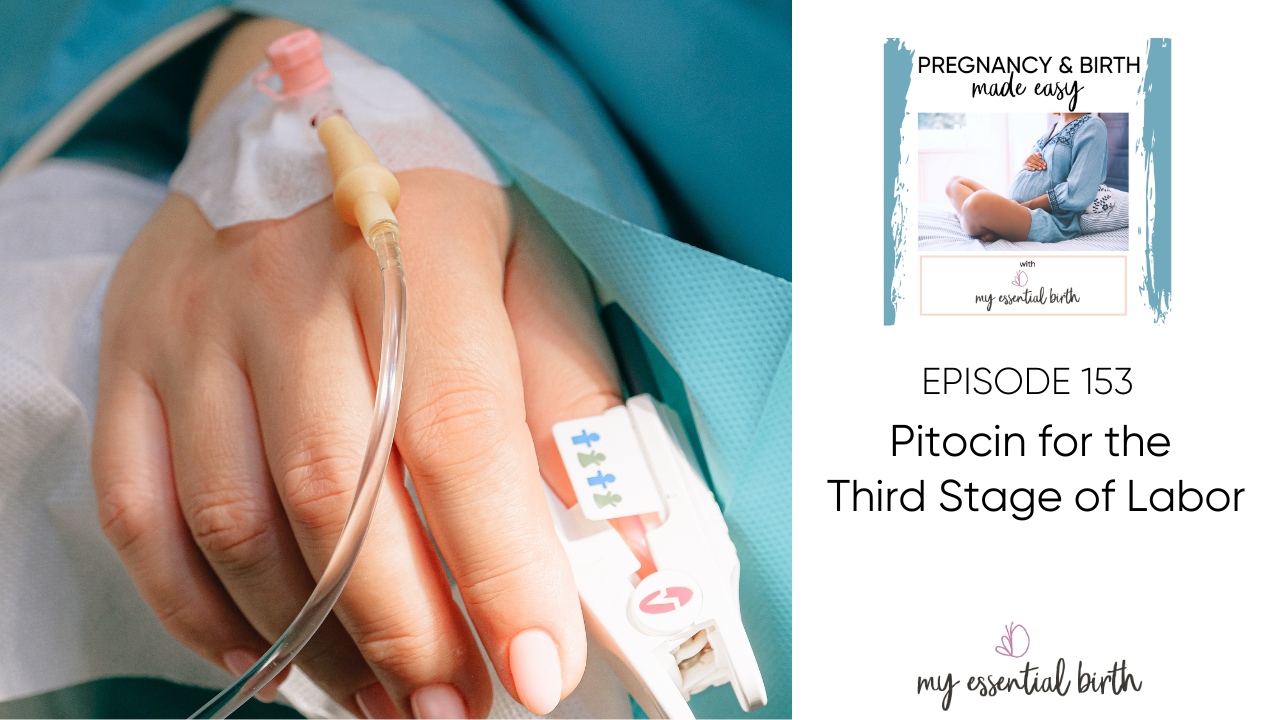
Pitocin for the Third Stage of Labor
Show Notes:
We tackle a question this week that catches many moms off guard when it comes to their birth process. “Why is my provider planning to give me a shot of Pitocin before I deliver my placenta?” We’re going to talk about all of your OPTIONS so you can make an informed decision.
[1:12] Our reviewer of the week is Mal1212 and she said: “I absolutely love learning about birth! I have had three babies (I’m pregnant with my fourth) and knew so little about the stages of birth, the options/rights that I have, and what I can do naturally on my own. I love how positive birth is portrayed and taught. I have gained confidence in my ability to give birth and other resources I can turn to for more support. Their birth course is amazing as well. Worth every penny!”
There is never a bad time to start learning about birth. Whether it’s your first baby or your fourth! I wish podcasts had been a thing when I had my first baby! I’ve learned so much from them. 💜
[2:25] I’m excited about this week’s episode because it’s a topic that has been coming up again and again more recently so it’s definitely time to talk about it. We’re going to talk about how Pitocin is used for the third stage of labor. I’ve had moms tell me that they wanted a completely unmedicated birth (no IV or medication) and then their providers or birth team started talking to them about hemorrhage and that they needed a shot of Pitocin which caught them off guard.
[3:05] Providers are supposed to talk to moms about the process of birth and what to expect, and I think that this stage gets skipped sometimes. When talking about the birth of the placenta, we focus on skin-to-skin, delayed cord clamping, etc. We forget about some management that takes place postpartum in regards to the birth of the placenta and the safety of mom and baby.
[3:49] I want to go over options you have when choosing options on how you want to deliver your placenta. This conversation needs to happen with your provider prior to being in labor.
[4:26] You get to choose! You have a say in EVERY step of the birth process and what is happening to your body (labor, birth, delivery, all of it!)
[4:51] Let’s answer the question I get the most about this topic: “Why is my provider planning to give me a shot of Pitocin before I deliver my placenta?”
[5:15] We’re going to talk about benefits, risks, different timelines, and scenarios in which you may need (or not need) Pitocin.
[6:12] My big soapbox is about informed consent. I follow a couple of doulas online who want to change it from “informed consent” to “informed CHOICE.” I love this idea!
[7:06] What falls under the third stage of labor? We’re talking about what happens after your baby is born and you’re delivering or birthing the placenta. We talk about what is happening in your body during that process.
[9:35] What are the three methods of managing the third stage of labor? Active management is the most common for hospital births. I define hemorrhage and what the complications can be.
[10:45] The CDC estimates “around 11% of pregnancy-related deaths are due to postpartum hemorrhage.” It is the leading cause of death on the day of birth. It is something that they want to and have to take control of quickly should anything happen.
[11:20] So what do they do in active management when it comes to the third stage of labor? First, the hospital will administer a uterotonic, Pitocin or Cytotec, which helps your uterus contract to deliver the placenta. This would be administered as a preventative measure and is usually accompanied by immediate clamping of the cord. After the cord has been clamped, they pull on the cord (cord traction) and push down on your belly.
[14:28] Side Note: I talk about how I feel regarding cord traction. Of course there are situations when active management can be useful, however, I believe that our bodies are capable and can deliver the placenta naturally.
[15:49] The other type of management is called expectant management or the “wait and watch” approach, which is practiced by most midwives. With the aid of early breastfeeding and skin-to-skin, the birth team will wait to see if your body requires any outside assistance to birth the placenta.
[16:44] I share my experience with my home birth and delivering my placenta.
[18:01] I talk about why it’s important that all of your placenta comes away from the uterine wall and the potential complications.
[19:39] We’re going to talk about some interventions in expectant management. I also talk about how it feels when you give birth to your placenta.
[21:25] Out of hospital midwives can use things like herbs, witch hazel, cohosh, etc. I also talk about a way to encourage the birth of the placenta which includes . . . wait for it . . . a small piece of the umbilical cord!
[23:22] The last type of management is called Mixed Management which combines the two previous types of management. We talk about different options that you can have.
[25:25] I don’t believe there’s any one way to manage the third stage of labor, BUT I do believe you should have a say.
[25:40] Based on studies that compared the different types of management, all women regardless of the risk for severe postpartum hemorrhage may have a reduced severe bleeding and anemia with the active management approach. This is why it’s considered the “gold standard” for reducing the risks of postpartum hemorrhage.
[26:28] Another few things to think about regarding active management, a baby is going to have a reduced birth weight because the cord is being cut immediately. There is also concern for cord traction causing postpartum hemorrhage and other complications.
[27:19] I talk about some things to consider if you’re a mom who is being induced and how to deal with managing the third stage.
I hope you took some notes or at least mental notes of things to discuss with your provider when it comes to managing the third stage of labor. There is never a bad time to have a conversation about what you are hoping to see happen during your birth process.
Feel free to email us at [email protected] or DM us on Instagram @myessentialbirth if you have any questions!
To Leave a Review ⭐️
- Open Apple Podcasts
- Find “Pregnancy & Birth Made Easy” podcast
- Select “Ratings and Reviews”
- Click the stars!
- Select “Write a Review” and tell us what was the most amazing, comforting, eye-opening thing that you loved!
ALL the best,

Links Mentioned:
Sources:



